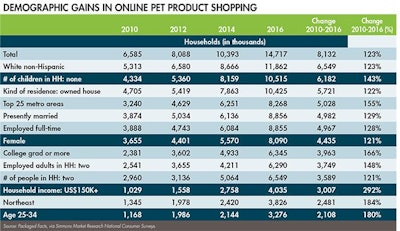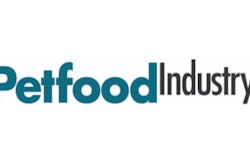
Online retailing now has significant influence on all consumers’ shopping decisions. The convenience of the internet being a “one-stop shop” is irresistible in a world that seems to be moving more quickly by the day.
A recent Euromonitor report, “Top 10 Global Consumer Trends for 2017,” outlined the appeal of online shopping. “In 2017, consumers are impatient,” said Daphne Kasriel-Alexander, consumer trends consultant for Euromonitor International. “The digital world has schooled more of them into becoming so-called ‘IWWIWWIWI’ — ‘I want what I want when I want it’ — consumers, impulsive and in pursuit of immediate gratification. They want services yesterday and real-time virtual dialogue with their brands. Ordering in advance is no longer enough.”
The growth of the internet as a pet food retail channel
Pet owners aren’t immune to this draw, and the numbers show growing effects on pet food retail channels. “The channel making the biggest strides is the internet channel, which now ranks as the fifth largest for pet products and as the third largest for pet supplies,” said Packaged Facts in its “US Pet Market Outlook” report, published in May 2017. “Indeed, the channel gained considerable share between 2014 and 2016 and is expected to capture even more in 2017, with the pet specialty chains losing share.”
According to the latest Packaged Facts data, in 2016 the internet held 7 percent of the U.S. retail channel sales for pet food and 15 percent for pet supplies, leading to an overall share of 9 percent for pet products (food + supplies). For comparison, in 2016 the independent pet specialty channel held 9 percent of the share of pet food sales, while the club channel held 10 percent of sales. The mass channel sat at 23 percent of the pet food market’s sales, while pet specialty chains held 20 percent of U.S. retail channel pet food sales in 2016.
“Online has inexorably moved out of its status as a niche channel, or as a consumer resource primarily used for pet care and pet product information-gathering,” said David Sprinkle, research director for Packaged Facts, in his May “Market Report” column for Petfood Industry magazine. “An information superhighway in the 1990s, the internet has morphed into a retail sales hypermarket.”
Demographics of online pet product shopping
Every demographic seems to be getting in on the internet-buying action when it comes to pet products, and numbers in many demographic channels more than doubled between 2010 and 2016 (see Table 1). Significant among these are some familiar demographics in pet ownership: households without children purchasing pet products online grew by 143 percent between 2010 and 2016; women purchasing pet products online grew by 121 percent; households with an income of US$150,000 or more shopping for pet products online increased 292 percent; and those ages 25–34 (the later millennials) increased their pet purchasing online by 180 percent between 2010 and 2016, according to data.

TABLE 1: Some familiar influential demographics appear when online pet product shopping is discussed, but nearly everyone can find the appeal in a convenient, instantly accessible retail channel.
Those pet owners doing online shopping for their pets are doing it more often, as well. According to American Pet Products Association data, 48 percent of pet owners bought pet food online in 2016 (up from 39 percent in 2014), and 45 percent of owners purchased treats online (compared to 37 percent in 2014). Whether they’re cat owners or dog owners doesn’t seem to make much of a difference, either. In 2014, 40 percent of dog owners and 39 percent of cat owners purchased pet food online — by 2016, those numbers had increased to 50 percent and 48 percent, respectively.
And what are those online purchasers buying for their pets exactly? According to data, everything from cleaning and training supplies to medications to pet food and treats — every segment of the pet industry is seeing growth in its online purchasing. And there’s definite movement in the areas of pet food and pet treats: according to Packaged Facts’ data, 49 percent of dog owners who buy pet products online said they bought dry pet food in the last 12 months and 43 percent said they bought pet treats; among cat owners purchasing pet products online, 42 percent said they bought dry pet food and 35 percent said they bought pet treats (see Figure 1).

FIGURE 1: Of those dog and cat owners who make online pet product purchases, a significant number buy pet food and/or treats via e-commerce.
The future of online retail shopping
“The internet age has clearly arrived,” said Euromonitor in its report, “Direct Selling and Communities in the Internet Age,” and it’s changing the retail playing field on an international level. “Internet retailing amounts to nearly US$1 trillion in sales,” said Euromonitor. “Developing countries are quickly leapfrogging developed ones, thanks to the growth of mobile internet networks.”
But what does it mean for the pet food industry? It means opportunity.
“E-commerce will not be a harbinger, but a differentiator,” said Euromonitor. The ability to give customers what they’re looking for (e.g., convenience and variety) as well as reaching customers in other, more developing markets (e.g., China, a developing pet market with significant growth attributed, in part, to the increased access the internet has provided urbanized pet owners), are two primary factors that the industry could, and should, use to its benefit.
As internet retailing (both overall and in the pet industry specifically) is expected to continue growing for the foreseeable future, it’s at the very least an area to watch in terms of opportunity and expansion.
Today’s trends, tomorrow’s commerce: the lure of internet retailing for consumers
According to Euromonitor International’s report, “Direct Selling and Communities in the Internet Age,” it’s difficult to predict what consumers will want in the future. However, keeping tabs on today’s preferences can inform business strategy. Here are the top three trends that, according to Euromonitor, impact internet sales:
Personalization
“Big Data and the self-selecting nature of the internet will help move products that appear personalized and meet individual needs,” said Euromonitor in its report. For pet food purchasers, this means being able to find formulas specific to their pet’s needs, be it a limited ingredient diet, an allergen-specific formula or a premium formula with a specific alternative protein or other ingredient.
Convenience
“Give shoppers options, because if you don’t someone else will,” said Euromonitor. “More options means more for current customers to buy and more to attract new ones.” If pet owners don’t live near a specialty pet food store or don’t have time to go out, they may just go online instead. Most online stores offer everything from next-day shipping to special ordering, so having an online presence could make the difference between getting a product in a consumer’s hands quickly and being lost in the shuffle.
Engagement
“The internet (mobile in particular) increasingly offers avenues for escape and entertainment,” said Euromonitor. “Brands that make interaction fun benefit.” Beyond simple product purchasing, pet consumers (like everyone else) are looking to engage with brands, and they’re looking to the internet to do it. Social media, interactive websites and other online-based methods of communicating provide new avenues for companies to connect with their customers.
Expert opinion: what e-commerce strength and growth mean for pet food players
www.petfoodindustry.com/blogs/7-adventures-in-pet-food/post/6477


















